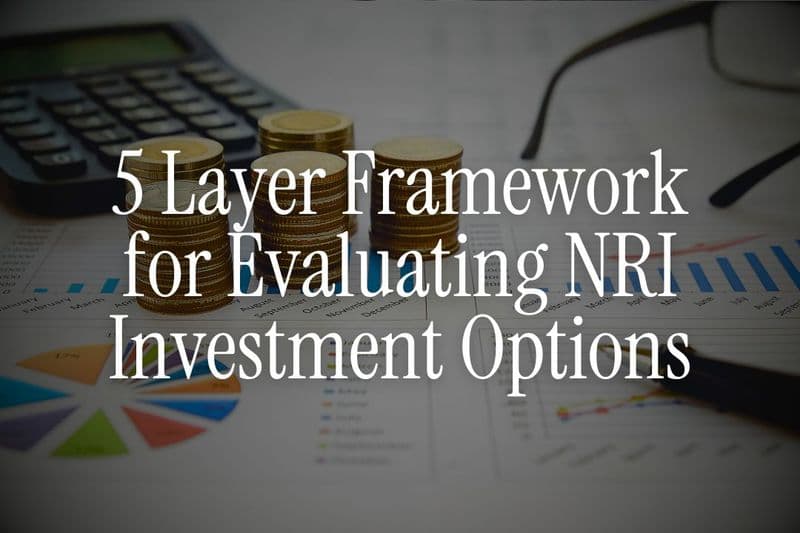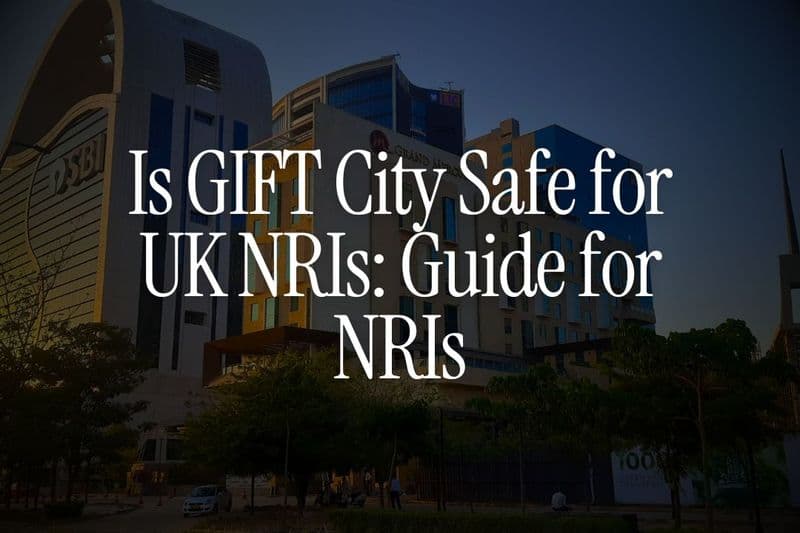
Last month, an NRI friend in Dubai called me. He'd just lost ₹8 lakhs because he invested in a "tax-free" scheme that promised 15% returns. The company wasn't RBI-registered. The money vanished.
This happens more than you think.
According to a recent SBNRI survey, 53% of NRIs believe India offers better investment prospects than many foreign markets.
That's great news. But here's the problem: most NRIs evaluate investments based on what their cousin's friend told them on WhatsApp.
At Belong, we've spent years advising NRIs on investments. We've seen every mistake, every regret, every "I wish I'd known this earlier" moment. Our team has created tools like the NRI FD rates explorer and compliance compass because we understand what keeps NRIs up at night: Will my money be safe? Can I bring it back? What about taxes?
Today, I'm sharing the exact framework our team uses when evaluating any investment opportunity for NRIs. Five layers.
Each one critical. Miss even one layer, and you could end up like my friend in Dubai.
Why Most NRIs Evaluate Investments Wrong
Here's what typically happens:
You see a social media ad promising 12% returns. Your relative mentions a property deal. A friend swears by a mutual fund. You compare the percentages, pick the highest number, and invest.
Wrong approach.
NRIs should evaluate factors such as liquidity needs, investment horizon, and tax implications in both their resident and home countries. Returns are just one piece of the puzzle.
Think about it: A fixed deposit offering 7% might beat a mutual fund promising 15% if the FD is tax-free and the mutual fund faces 30% taxation.
You need a systematic method to evaluate every investment. That's where the 5-Layer Framework comes in.
The 5-Layer Framework Explained
Layer 1: The Safety Check
Before you look at returns, ask: Is this investment legally allowed? Is the provider regulated?
NRIs can invest in Indian securities through various schemes but must adhere to FEMA regulations on repatriation and account types.
Here's your safety checklist:
Regulatory approval: Is the product approved by RBI, SEBI, or IFSCA? For banks, check if they have an RBI license. For mutual funds, verify SEBI registration. For GIFT City products, confirm IFSCA approval.
FEMA compliance: FEMA governs the inflow and outflow of foreign currency and regulates NRI investments in India. Some investments are restricted for NRIs. Agricultural land? Not allowed. Equity derivatives? Only through NRO accounts on a non-repatriation basis.
Company track record: How long has the provider been operating? What's their financial health? Check credit ratings for banks and debt instruments.
Investment limits: RBI regulations prohibit NRIs from investing in certain industries such as atomic energy, railways, tobacco, gambling, and chit funds.
👉 Tip: Use our Compliance Compass tool to quickly check if an investment type is allowed for your residential status.
Real example: GIFT City fixed deposits are approved by IFSCA and follow international banking standards. That's why Belong chose GIFT City as our starting point for NRI investments.
Layer 2: The Tax Blueprint
This is where most NRIs lose money without realizing it.
You need to check three tax angles:
1. Tax in India
Capital gains from mutual funds are taxable in India as per holding period and fund type. Different investments have different tax treatments:
- NRE FD interest: Tax-free in India
- NRO FD interest: Taxed at ~30% plus surcharge
- Equity LTCG: 12.5% above ₹1.25 lakh
- Debt mutual funds: As per slab rate
- GIFT City FD interest: Tax-free for NRIs
2. Tax in your residence country
Just because an investment is tax-free in India doesn't mean it's tax-free where you live. Check your country's tax laws. Many NRIs in the US face PFIC complications with Indian mutual funds.
3. DTAA benefits
The Double Taxation Avoidance Agreement (DTAA) provides relief, ensuring you don't pay tax twice on the same income.
You need to obtain a Tax Residency Certificate (TRC) from your country and file Form 10F in India to claim DTAA benefits. Our India-UAE DTAA guide explains this in detail.
Calculate the effective tax rate after considering both countries and DTAA relief. That's your real tax cost.
👉 Tip: Join our WhatsApp community where our tax experts answer specific DTAA questions every week.
Layer 3: The Currency Angle
This layer separates smart NRI investors from the rest.
When NRIs invest in Indian mutual funds, the investments are made in Indian Rupees (INR). While the fund may deliver positive returns in INR terms, the actual gains in the investor's home currency (such as USD, GBP, or AED) can be affected by currency fluctuations.
Let's say you invest ₹10 lakh in an NRE FD at 7% for one year. The rupee was ₹83 per dollar when you invested ($12,048).
After one year:
- Your maturity amount: ₹10.7 lakh
- But the rupee depreciated to ₹88 per dollar
- Your dollar value: $12,159
- Actual dollar return: 0.9% (not 7%)
Currency risk ate most of your returns.
Three ways to handle this:
Option 1: Accept the risk if you plan to use the money in India (buying property, retirement expenses).
Option 2: Hedge through forex contracts. Some banks offer this, but it costs money and reduces returns.
Option 3: Invest in dollar-denominated products. This is why GIFT City fixed deposits are attractive - they're in USD, so no currency risk.
👉 Tip: Use our Rupee vs Dollar tracker to understand historical currency trends before making long-term rupee investments.
Dollar-denominated investments, such as Exchange-Traded Funds (ETFs), US-based savings accounts, and international real estate, offer NRIs an enhanced alternative.
Layer 4: The Exit Strategy
Can you access your money when you need it? Can you move it abroad?
This is the layer that surprises most NRIs. They invest easily but struggle to get their money out.
Check three things:
1. Liquidity:
How quickly can you convert the investment to cash?
- Savings accounts: Immediate
- FDs: Break penalty applies if withdrawn early
- Real estate: Takes months to sell
- Unlisted equity: Hard to exit
Fixed Deposits, or FDs, are among the safer ways to invest in India for an NRI. This investment can help you earn a fixed-interest income. The tradeoff is lower liquidity compared to savings.
2. Repatriation rules:
Up to USD 1 million can be repatriated per financial year across all the NRO bank accounts held by an NRI.
Investment through NRE account: Fully repatriable (no limits). Investment through NRO account: USD 1 million per year limit.
This matters enormously. Invest ₹5 crore through NRO? You're limited to repatriating about $1 million yearly. At current rates, that's roughly ₹8.5 crore. You'll need multiple years to move all your money.
Our repatriation guide for NRIs covers every scenario you might face.
3. Documentation required:
Documentation for NRO Account includes Form 15CA, Form 15CB, Form A2, and a bank request form.
The bank asks: "Prove you bought this with NRE funds." If you don't have the original NRE account statement from 2010 showing the debit, you can't claim unlimited repatriation.
Keep all investment documents organized from day one. Missing paperwork can block repatriation.
👉 Tip: Cloud storage like Google Drive is essential. Upload every investment statement, bank transfer proof, and tax document. You'll thank yourself later.
Layer 5: The Return Reality
Only after clearing the first four layers should you evaluate returns.
Here's what to check:
Historical performance: What did this investment actually deliver over 5-10 years? Not what they're promising, but what they delivered.
Higher IRR values typically indicate more attractive investment opportunities. However, IRR can be complex to calculate for projects with irregular cash flows.
Risk-adjusted returns: A mutual fund giving 15% with 30% volatility is riskier than an FD giving 7% with zero volatility. Adjust expectations based on your risk tolerance.
Realistic projections: Be skeptical of anything promising double-digit guaranteed returns. NRE FDs offer higher interest rates compared to savings accounts and are available in flexible tenures to suit various investment horizons. Current NRE FD rates range from 6-7.5% for most banks.
Fee impact: Factor in brokerage, management fees, exit loads, and forex conversion charges. These eat into returns quietly.
Inflation adjustment: A 7% return sounds great until you realize India's inflation is running at 5-6%. Your real return is closer to 1-2%.
Compare apples to apples. Don't compare a risky equity fund's potential return with a safe FD's guaranteed return.
Applying the Framework: Real Examples
Let's apply this framework to common NRI investments:
Example 1: NRE Fixed Deposit vs GIFT City USD FD
Layer | NRE FD (HDFC) | GIFT City USD FD (Belong) |
|---|---|---|
Safety | RBI regulated ✓ | IFSCA regulated ✓ |
Tax | Interest tax-free in India ✓ | Interest tax-free for NRIs ✓ |
Currency | Rupee risk ✗ | Dollar-denominated ✓ |
Exit | Fully repatriable ✓ Premature penalty | Fully repatriable ✓ Better liquidity |
Returns | ~7% in INR | ~5% in USD (hedged against INR) |
For someone planning to return to the US, the USD FD wins despite the lower rate because it eliminates currency risk. For someone retiring in India, the NRE FD works fine.
Example 2: Direct equity vs equity mutual funds
Both need Layer 1 (PIS account, SEBI-registered broker). Both have similar tax treatment (Layer 2). But mutual funds offer professional management and diversification (Layer 5), while direct equity needs your time and expertise.
Investing through a Systematic Investment Plan (SIP) enables NRIs to invest regularly in a disciplined manner, averaging out market highs and lows over time.
Check our best mutual funds guide for NRIs for detailed comparisons.
Common Mistakes NRIs Make
Many NRIs ignore NRI taxation rules and face penalties later. Opening NRO account when you need repatriation, or vice versa. Incomplete KYC leading to account freezing or transaction blocks.
Mistake 1: Chasing returns without checking safety
That 15% "guaranteed" return scheme my Dubai friend fell for? It failed Layer 1. No regulatory approval.
Mistake 2: Ignoring tax in residence country
Most repatriation mistakes stem from poor planning and incomplete knowledge. US-based NRIs investing in Indian mutual funds without understanding PFIC rules often owe huge tax bills.
Mistake 3: Not planning repatriation
Rohit sold four apartments he'd purchased with NRE funds, thinking he could repatriate all proceeds freely. Only after the fourth sale did he learn about the two-property limit.
He now has ₹2 crore stuck in NRO, repatriable only at $1 million per year.
Mistake 4: Mixing account types
When you move abroad and become an NRI, FEMA (Foreign Exchange Management Act) prohibits you from continuing to use regular resident savings accounts for investments.
Convert your accounts. Update your KYC. Follow the rules. Our guide on converting resident accounts to NRI accounts walks you through this.
Mistake 5: Not documenting properly
Every bank statement, every investment confirmation, every tax receipt - save everything. Missing documents years later can block repatriation.
How Belong Helps You Apply This Framework
At Belong, we've built our entire platform around this 5-layer framework.
Layer 1 - Safety: We only offer products from IFSCA-regulated institutions. Our GIFT City FDs come from established banks with strong credit ratings.
Layer 2 - Tax: GIFT City offers tax-free returns for NRIs. No TDS deductions. No complicated tax filings for the interest income.
Layer 3 - Currency: USD-denominated deposits eliminate currency risk. Lock in your dollar value today.
Layer 4 - Exit: Full repatriation. No million-dollar annual limits. Withdraw anytime with minimal penalties. We handle all documentation.
Layer 5 - Returns: Transparent, guaranteed returns. No hidden fees. What you see is what you get.
We're not saying GIFT City FDs are perfect for everyone. They're one option. But they score well across all five layers, which is rare.
Our FD comparison tool lets you compare traditional NRE/NRO/FCNR deposits with GIFT City options side by side.
Your Next Steps
Start using this framework today:
List all your current investments. Go through each one using the 5-layer check. You'll likely find at least one red flag.
Use our tools. The Residential Status Calculator determines your tax status. The Compliance Compass checks if your investments are FEMA-compliant.
Join our community. Over 5,000 NRIs in our WhatsApp community discuss investment decisions weekly. Ask questions. Share experiences. Learn from others' mistakes.
Download the Belong app. Explore tax-free USD fixed deposits in GIFT City. Compare rates. Get personalized advice from our team. Get started here.
Stay informed. Our blog covers every NRI investment topic. From NRI tax filing to DTAA benefits, we've got you covered.
The next time someone pitches you an investment opportunity, don't just look at the return percentage. Run it through the 5-layer framework. Check safety. Calculate real tax impact. Understand currency implications. Verify the exit strategy. Only then evaluate returns.
Your financial future deserves this level of diligence.
Sources:
- HDFC Life International - NRI Investment Plans: https://www.hdfclife-international.com/blog/nri-investment-plans/
- FEMA Guidelines (RBI): https://www.rbi.org.in
- Kotak Mutual Fund - NRI Investment in Mutual Funds: https://www.kotakmf.com/Information/blogs/nri-investment-in-mutual-funds_
- GetBelong - Common Mistakes NRIs Make When Investing in Mutual Funds: https://getbelong.com/blog/mutual-funds/investment-mistakes/
- GetBelong - NRI Repatriation Rules: https://getbelong.com/blog/repatriation-rules-for-nris-after-selling-investments-in-india/




